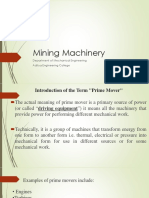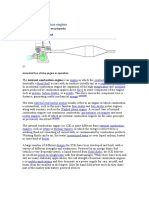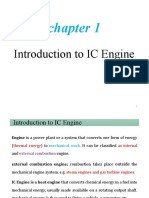engine
Uploaded by
vickyegateengine
Uploaded by
vickyegateAn engine is a machine designed to convert energy into mechanical work, typically to perform tasks such as
moving vehicles, generating electricity, or powering machines. Engines are crucial components in various
applications, ranging from automobiles to industrial machinery to power plants. There are several types of
engines, each with specific working principles and uses.
Types of Engines:
Internal Combustion Engine (ICE):
Definition: This is the most common type of engine used in vehicles and small machines. It works by burning
fuel (such as gasoline, diesel, or natural gas) inside a combustion chamber to generate power.
Working Principle: The fuel-air mixture is ignited inside a cylinder, causing an explosion that pushes a piston.
This movement of the piston is transferred to the crankshaft, which converts it into rotational motion.
Types:
Gasoline Engine: Uses gasoline as fuel. It often features spark ignition.
Diesel Engine: Uses diesel fuel. It relies on compression ignition (the fuel ignites due to high pressure).
Two-Stroke Engine: Completes a power cycle in two strokes of the piston (used in small, lightweight machines
like motorcycles and chainsaws).
Four-Stroke Engine: Completes a power cycle in four strokes of the piston (commonly used in cars and trucks).
External Combustion Engine:
Definition: In these engines, combustion occurs outside the engine's working parts, and the heat is transferred
to the engine's working fluid.
Example: Steam engines, which burn fuel to heat water in a boiler, creating steam. The steam pressure then
drives a piston or turbine.
Electric Engine (Electric Motor):
Definition: An electric engine uses electrical energy to produce mechanical energy, typically by converting
electrical power into rotational motion using magnets and coils of wire.
Working Principle: An electric current passing through a coil in a magnetic field creates a force on the coil,
causing it to spin. This spinning motion is transferred to mechanical parts.
Applications: Electric cars, fans, household appliances, industrial machines.
Turbine Engines:
Definition: These engines convert the energy from moving fluids (such as steam, gas, or water) into
mechanical energy by spinning a rotor.
Types:
Gas Turbine Engine: Often used in aircraft, power plants, and marine vessels. They work by expanding high-
pressure gas from combustion through a turbine to generate power.
Steam Turbine: Often used in power plants. Water is heated to produce steam, which then spins the turbine
blades.
Jet Engine:
Definition: A type of gas turbine engine that propels aircraft by expelling a high-speed jet of gas.
Working Principle: Air is drawn in, compressed, mixed with fuel, and ignited. The resulting high-pressure
exhaust gases are expelled through the nozzle to generate thrust.
Applications: Airplanes, rockets, missiles.
Components of a Typical Engine:
Cylinder: The space where fuel combustion occurs. Most engines use multiple cylinders arranged in different
configurations (e.g., inline, V-shaped).
Piston: A movable component inside the cylinder that is pushed by the combustion of fuel and transfers this
force to the crankshaft.
Crankshaft: A rotating shaft that converts the linear motion of the piston into rotational motion to drive the
vehicle or machinery.
Valves: Components that control the intake of fuel/air mixture into the cylinder and the exhaust of combustion
gases. These are controlled by camshafts.
Spark Plug: In gasoline engines, a spark plug ignites the fuel-air mixture in the cylinder.
Fuel System: Supplies the engine with the appropriate fuel (e.g., fuel injectors in modern engines or
carburetors in older models).
Cooling System: Prevents the engine from overheating, typically using a liquid coolant or air flow.
Lubrication System: Keeps engine parts lubricated to reduce friction and wear, ensuring smooth operation.
Working Cycle of an Internal Combustion Engine:
You might also like
- The Dodges and Their Potteries - Maine Antique Digest February 2018100% (1)The Dodges and Their Potteries - Maine Antique Digest February 20183 pages
- Project Intro Internal Combustion EngineNo ratings yetProject Intro Internal Combustion Engine4 pages
- Introduction and working principle of IC engineNo ratings yetIntroduction and working principle of IC engine2 pages
- Mining Machinery: Department of Mechanical Engineering Aditya Engineering CollegeNo ratings yetMining Machinery: Department of Mechanical Engineering Aditya Engineering College35 pages
- Internal Combustion Engine: From Wikipedia, The Free Encyclopedia Jump ToNo ratings yetInternal Combustion Engine: From Wikipedia, The Free Encyclopedia Jump To7 pages
- Siege Engine Electric Engine: NomenclatureNo ratings yetSiege Engine Electric Engine: Nomenclature11 pages
- GE 109 Internal Combustion Engine - 2022meb1322No ratings yetGE 109 Internal Combustion Engine - 2022meb13226 pages
- 002 Combustion Engine Assignment of Malik Gulshair AliNo ratings yet002 Combustion Engine Assignment of Malik Gulshair Ali7 pages
- Internal Combustion Engine - Lab Report 2No ratings yetInternal Combustion Engine - Lab Report 2154 pages
- Work Output and Efficiency Measurement of Diesel Engines PDF100% (2)Work Output and Efficiency Measurement of Diesel Engines PDF30 pages
- Engine: Machine Energy Mechanical EnergyNo ratings yetEngine: Machine Energy Mechanical Energy79 pages
- Ic Engines: Presented By, Yuvaraja MM M Tech in Renewable Energy NMIT, BengaluruNo ratings yetIc Engines: Presented By, Yuvaraja MM M Tech in Renewable Energy NMIT, Bengaluru18 pages
- Interpersonal Relationship:: Raja Abdul Rehman FA19-BBA-199No ratings yetInterpersonal Relationship:: Raja Abdul Rehman FA19-BBA-1993 pages
- SDET Bottles Filling and Capping Machine Operation ManualNo ratings yetSDET Bottles Filling and Capping Machine Operation Manual10 pages
- Dual Full-Bridge MOSFET Driver With Microstepping TranslatorNo ratings yetDual Full-Bridge MOSFET Driver With Microstepping Translator18 pages
- HUAWEI CUN U29-Bitel Phone Upgrade Guide - V1.1 - 20161128No ratings yetHUAWEI CUN U29-Bitel Phone Upgrade Guide - V1.1 - 2016112810 pages
- Class Schedule Sy 2021 2022 Senior High SchoolNo ratings yetClass Schedule Sy 2021 2022 Senior High School2 pages
- General Questions For Interview: Q1: Tell Me About YourselfNo ratings yetGeneral Questions For Interview: Q1: Tell Me About Yourself5 pages
- Essentials of Oceanography 12th Edition Trujillo Test Bank - Quickly Download And Never Miss Important Content100% (2)Essentials of Oceanography 12th Edition Trujillo Test Bank - Quickly Download And Never Miss Important Content49 pages
- BS EN 15004-5-2008 Fixed Firefighting Systems HFC 227ea Extinguishant PDFNo ratings yetBS EN 15004-5-2008 Fixed Firefighting Systems HFC 227ea Extinguishant PDF16 pages
- Specialized Cte Industry Certification ListNo ratings yetSpecialized Cte Industry Certification List14 pages
- Phutikettrkit,+3 +RFID+Hospitals+-+Edited+by+HBDSNo ratings yetPhutikettrkit,+3 +RFID+Hospitals+-+Edited+by+HBDS10 pages
- Grammatical Signals Pattern of Development PartNo ratings yetGrammatical Signals Pattern of Development Part4 pages

























































































